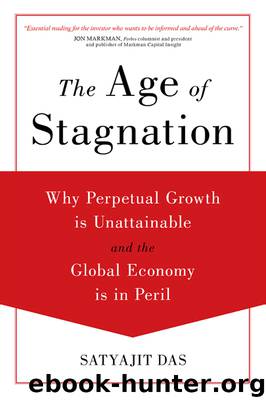The Age of Stagnation by Satyajit Das

Author:Satyajit Das
Language: eng
Format: epub
ISBN: 9781633881594
Publisher: Prometheus Books
Published: 2016-01-13T16:00:00+00:00
The relationship between the developed and emerging worlds is long, complex, and fraught with tension. Historically, the developing world was seen as a new frontier to be conquered. From the 1500s, the European powers expanded, acquiring land and new resources to complement the increasingly intensive exploitation of their homelands. Voyages of exploration and discovery opened up trade routes. Trading relationships evolved into colonial empires.
Conquest of these often sophisticated countries was made possible by Europe's superior military power. This in turn was supported by superior industrial and scientific technologies, as well as highly evolved legal systems, property rights, politics, and systems of government. It was also underpinned by cultural attitudes and work ethics, which rewarded individual skill, energy, and dynamism. By the nineteenth century, England, Spain, Portugal, the Netherlands, Italy, France, and Germany had established major colonies in Asia, Africa, and the Americas, built upon what English naturalist Alfred Russel Wallace termed “the unblushing selfishness of the greatest civilized nations.”1
The objective was to strengthen economic and political power by controlling key resources and strategic trading routes, and to deny these advantages to sovereign rivals. Over time, the colonies came to resemble modern global supply chains. In a thoroughly contemporary twist, Britain even outsourced the management of its colonies to private interests, the British East India Company.
Colonialism provided access to low-cost raw materials, fueling the growth and prosperity of the Old World. It provided cheap labor, often in the form of slaves, and new markets for the products of the colonial powers. Portuguese explorer Vasco da Gama was exultant at being able to buy pepper from indigenous traders in the East Indies for 3 ducats a hundredweight, knowing it would fetch 80 ducats in Venice. Silver from the Potosí mine in Bolivia and gold looted by the Conquistadors helped finance the Spanish empire.
Karl Marx approved: “the question…is not whether the English had a right to conquer India, but whether we are to prefer India conquered by the Turk, by the Persian, by the Russian, to India conquered by the Briton.”2 While recognizing that the East India Company was exploiting Indian markets and labor, Marx argued that capitalism would transform the subcontinent. India would benefit from the fruits of the Industrial Revolution. It was a sentiment worthy of George MacDonald Fraser, creator of the fictional illustrious Victorian soldier Sir Harry Paget Flashman, who regarded the British empire as the greatest thing that ever happened to an undeserving world.3
The link between earthly power and spiritual glory provided justification for colonial conquest: “It amounted to a theory of cultural destiny—that the European maritime nations were destined to bring Christianity and civilization to a pagan and savage world, and their reward was to be the wealth and riches which the indigenous populations themselves were incapable of appreciating and valuing.”4
After World War II, many colonies gained independence. In his landmark “tryst with destiny” speech on August 14, 1947, the post-independence Indian prime minister, Jawaharlal Nehru, voiced the aspirations of all former colonies. He spoke of freedom and the hopes for a future shaped by an emancipated native population.
Download
This site does not store any files on its server. We only index and link to content provided by other sites. Please contact the content providers to delete copyright contents if any and email us, we'll remove relevant links or contents immediately.
The Secret History by Donna Tartt(16622)
The Social Justice Warrior Handbook by Lisa De Pasquale(11489)
Thirteen Reasons Why by Jay Asher(7788)
This Is How You Lose Her by Junot Diaz(5770)
Weapons of Math Destruction by Cathy O'Neil(5036)
Zero to One by Peter Thiel(4824)
The Myth of the Strong Leader by Archie Brown(4789)
Promise Me, Dad by Joe Biden(4447)
Beartown by Fredrik Backman(4415)
Stone's Rules by Roger Stone(4415)
How Democracies Die by Steven Levitsky & Daniel Ziblatt(4398)
The Fire Next Time by James Baldwin(4342)
100 Deadly Skills by Clint Emerson(4076)
A Higher Loyalty: Truth, Lies, and Leadership by James Comey(4032)
Rise and Kill First by Ronen Bergman(4012)
The David Icke Guide to the Global Conspiracy (and how to end it) by David Icke(3881)
The Farm by Tom Rob Smith(3872)
Secrecy World by Jake Bernstein(3782)
The Doomsday Machine by Daniel Ellsberg(3730)
